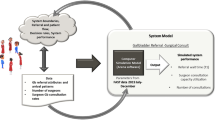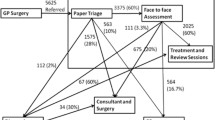Abstract
The United Kingdom's National Health Service (NHS) is investing considerable resources in reducing patient waiting times for elective treatment. This paper describes the development of a waiting list model and its use in a simulation to assess management options. Simulation usually assumes that waiting is adequately described by simple queuing disciplines, typically first-in-first-out. However, waiting in the United Kingdom's NHS is a more complex phenomenon. The waiting list behaviour is explored through an analysis of the changes in waiting time distributions for elective orthopaedics in one Scottish Health Board, NHS Fife. The evolving distributions suggest that there have been substantial changes in priorities in response to the various NHS targets. However, in the short or medium term, the form of the distribution appears reasonably stable, providing a basis for estimating future waiting times in different scenarios. A model of the waiting behaviour and prioritization in the appointment allocations was embedded in a simulation of the complete elective orthopaedic patient journey from referral, through outpatients and diagnostics to surgery. The model has been used to explore the consequences of various management options in the context of the NHS target that no patient should wait more than 18 weeks between referral and treatment.






Similar content being viewed by others
References
Appleby J, Boyle S, Devlin N, Harley M, Harrison A, Locock L and Thorlby R (2005). Sustaining reductions in waiting times: Identifying successful strategies, King's Fund, http://www.kingsfund.org.uk/publications/kings_fund_publications/sustaining.html, accessed 13 August 2008.
Audit Scotland (2006). Tackling waiting times in the NHS in Scotland, http://www.audit-scotland.gov.uk/docs/health/2005/nr_060216_waiting_times_km.pdf, accessed 13 August 2008.
Bevan G and Hood C (2006). Have targets improved performance in the English NHS? BMJ 332: 419–422.
Cameron R, Dugdale RE and Page MJ (2006). A capacity planning simulation model and its application to a nuclear medicine service. ESM'2006, LAAS, Toulouse, France. http://lattice-net.co.uk/ESM2006_BIO-04_Cameron_etal.doc, accessed 24 July 2008.
Carvel J (2007). Public sector targets to be scrapped, The Guardian, 18 July 2007. Available at http://www.guardian.co.uk/uk/2007/jul/18/politics.topstories3, accessed 13 August 2008.
The CheckList Partnership (2007). Modelling the 18 week wait: A practical guide for CheckList users, http://www.checklist.co.uk/h_18.htm, accessed 13 August 2008.
Culyer AJ and Cullis JG (1976). Some economics of hospital waiting lists in the NHS. J Social Pol 5: 239–264.
Goddard J and Tavakoli M (2008). Efficiency and welfare implications of managed public sector hospital waiting lists. Eur J Opl Res 184: 778–792.
ISD Scotland (2008). Waiting times statistical publication notice, http://www.isdscotland.org/isd/5413.html, accessed 24 July 2008.
Jun JB, Jacobson SH and Swisher JR (1999). Application of discrete-event simulation in health care clinics: A survey. J Opl Res Soc 50: 109–123.
Moss L (2007). Troubleshoot teams sent in to cut cancer waiting times, The Scotsman, 30 May 2007. Available at http://news.scotsman.com/healthofthenhs/Troubleshoot-teams-sent-in-to.3290322.jp, accessed 13 August 2008.
Mullen P (2003). Prioritising waiting lists: How and why? Eur J Opl Res 150: 32–45.
NHS Scotland (2008). 18 Weeks: The referral to treatment standard, http://www.18weeks.scot.nhs.uk/, accessed 24 July 2008.
Ouwens J, Groen H, TenVergt E, Koërter G, Boer W, van der Bij W and National Steering Group for Lung Transplantation (2002). Simulated waiting list prioritization for equitable allocation of donor lungs. J Heart Lung Transpl 21: 797–803.
Proudlove NC, Black S and Fletcher A (2007). OR and the challenge to improve the NHS: Modelling for insight and improvement in in-patient flows. J Opl Res Soc 58: 145–158.
Ratcliffe J, Young T, Buxton M, Eldabi T, Paul R, Burroughs A, Papatheodoridis G and Rolles K (2001). A simulation modelling approach to evaluating alternative policies for the management of the waiting list for liver transplantation. Health Care Mngt Sci 4: 117–124.
Steyn R (2008). Improving patient flow, http://www.steyn.org.uk/, accessed 24 July 2008.
Torkki M, Linna M, Seitsalo S and Paavolainen P (2002). How to report and monitor the performance of waiting list management. Int J Technol Assess Health Care 18: 611–618.
Vasilakis C, Sobolev BG, Kuramoto L and Levy AR (2007). A simulation study of scheduling clinic appointments in surgical care: Individual surgeon versus pooled lists. J Opl Res Soc 58: 202–211.
Wall A and Worthington DJ (2007). Time-dependent analysis of virtual waiting time behaviour in discrete time queues. Eur J Opl Res 178: 482–499.
Worthington DJ (1987). Queuing models for hospital waiting lists. J Opl Res Soc 38: 413–422.
Acknowledgements
The study was only possible due to the support of NHS Fife providing funding, data and the collaboration of many staff.
Author information
Authors and Affiliations
Corresponding author
Rights and permissions
About this article
Cite this article
Bowers, J. Waiting list behaviour and the consequences for NHS targets. J Oper Res Soc 61, 246–254 (2010). https://doi.org/10.1057/jors.2008.149
Received:
Accepted:
Published:
Issue Date:
DOI: https://doi.org/10.1057/jors.2008.149




